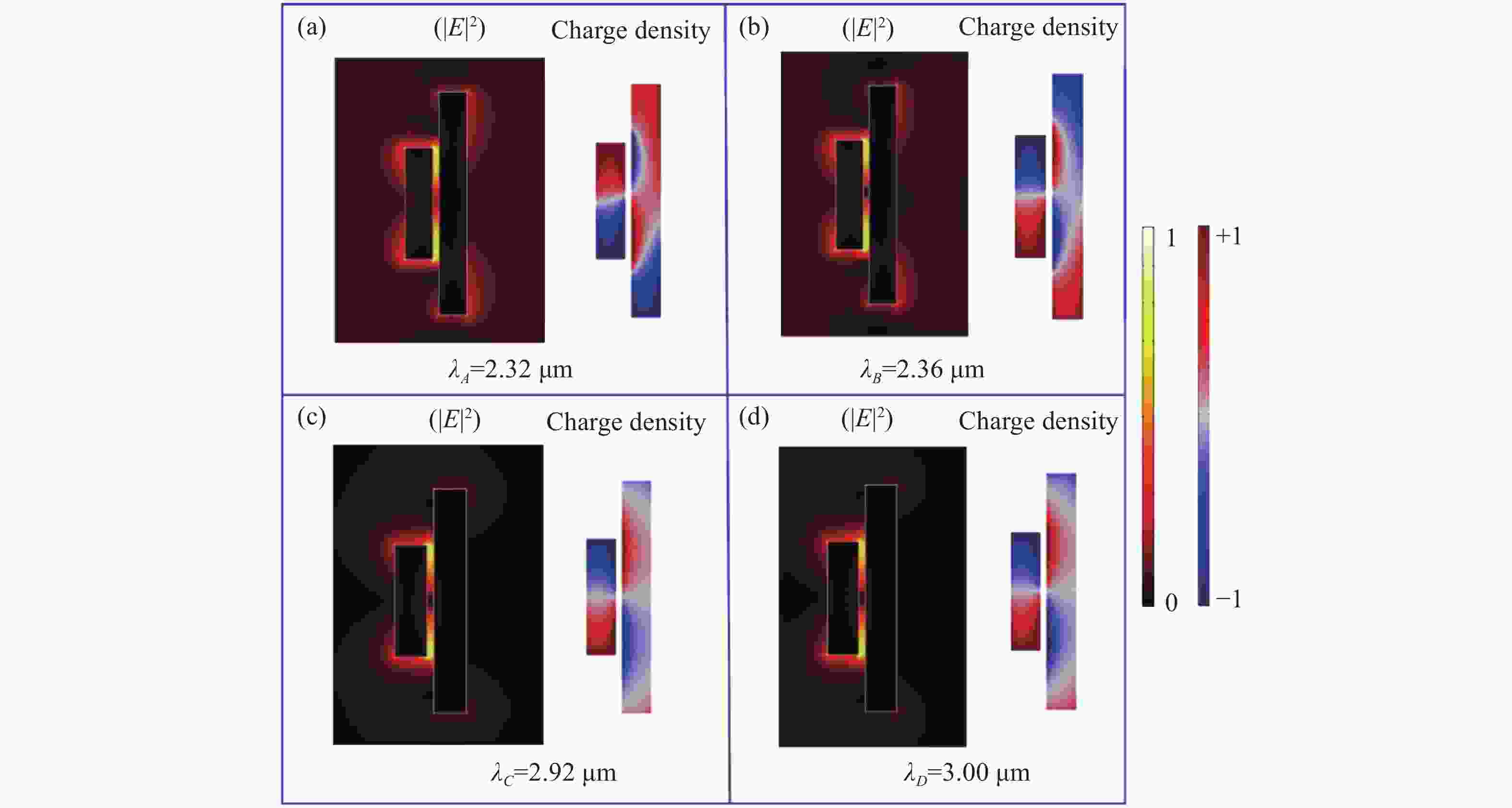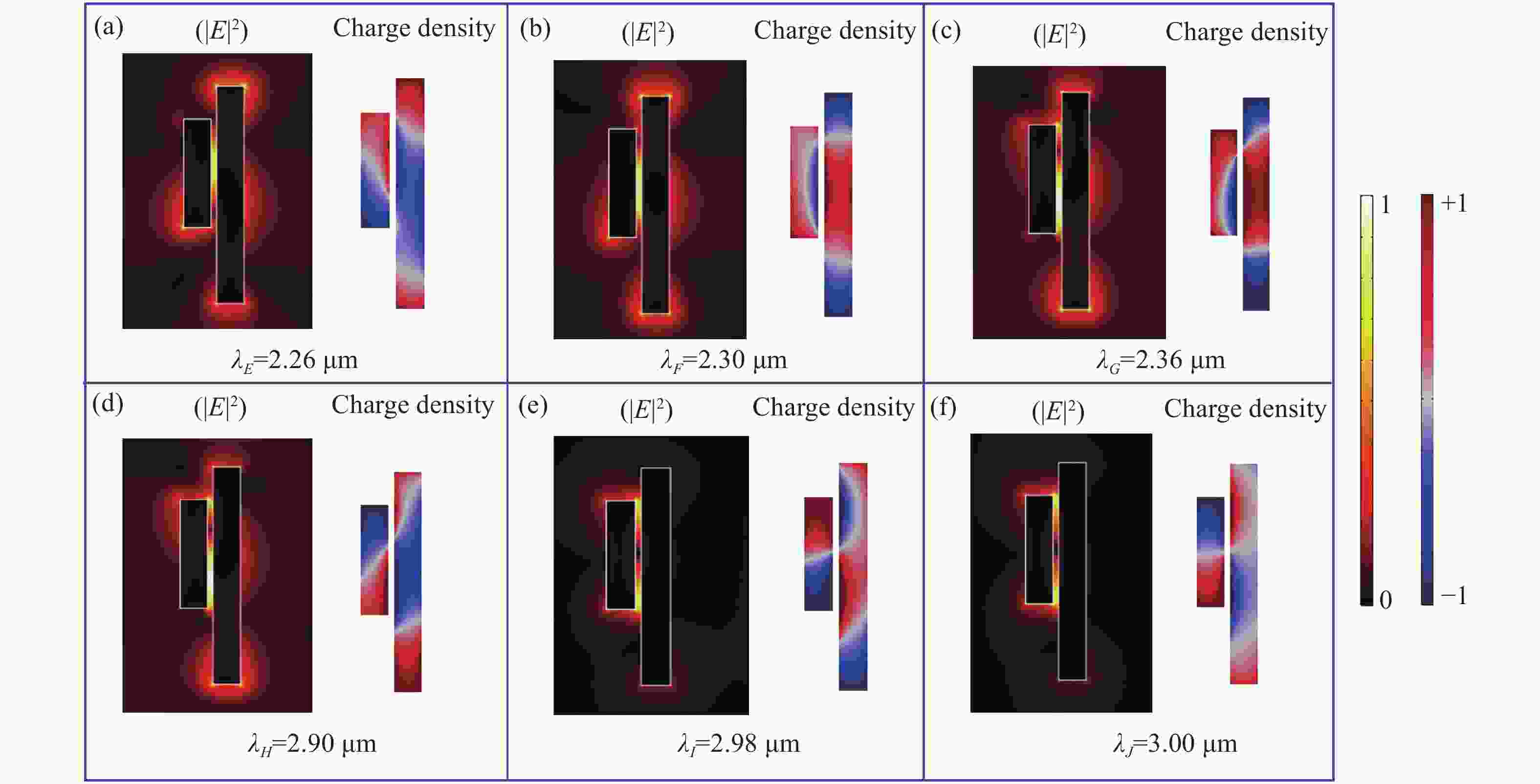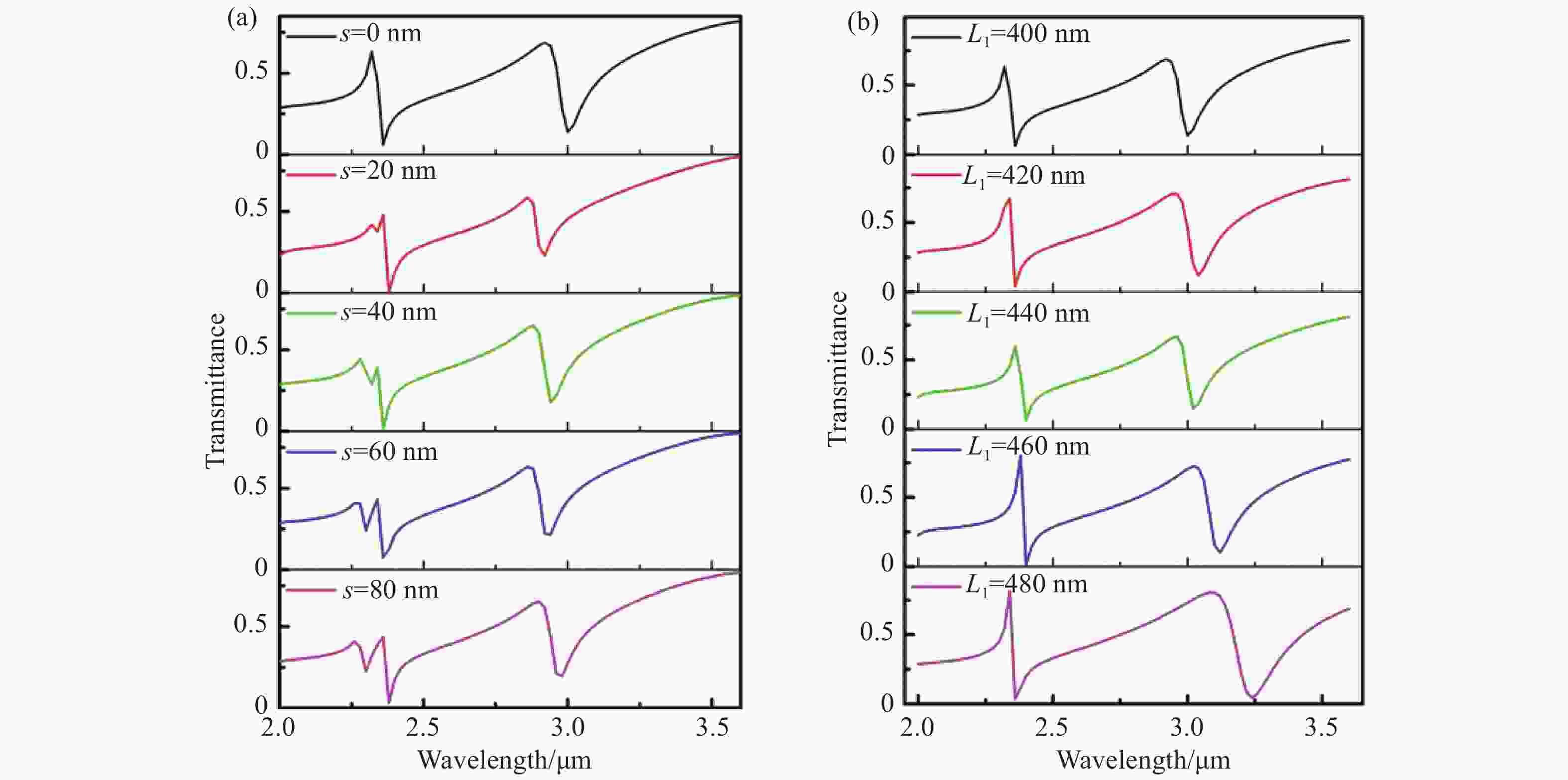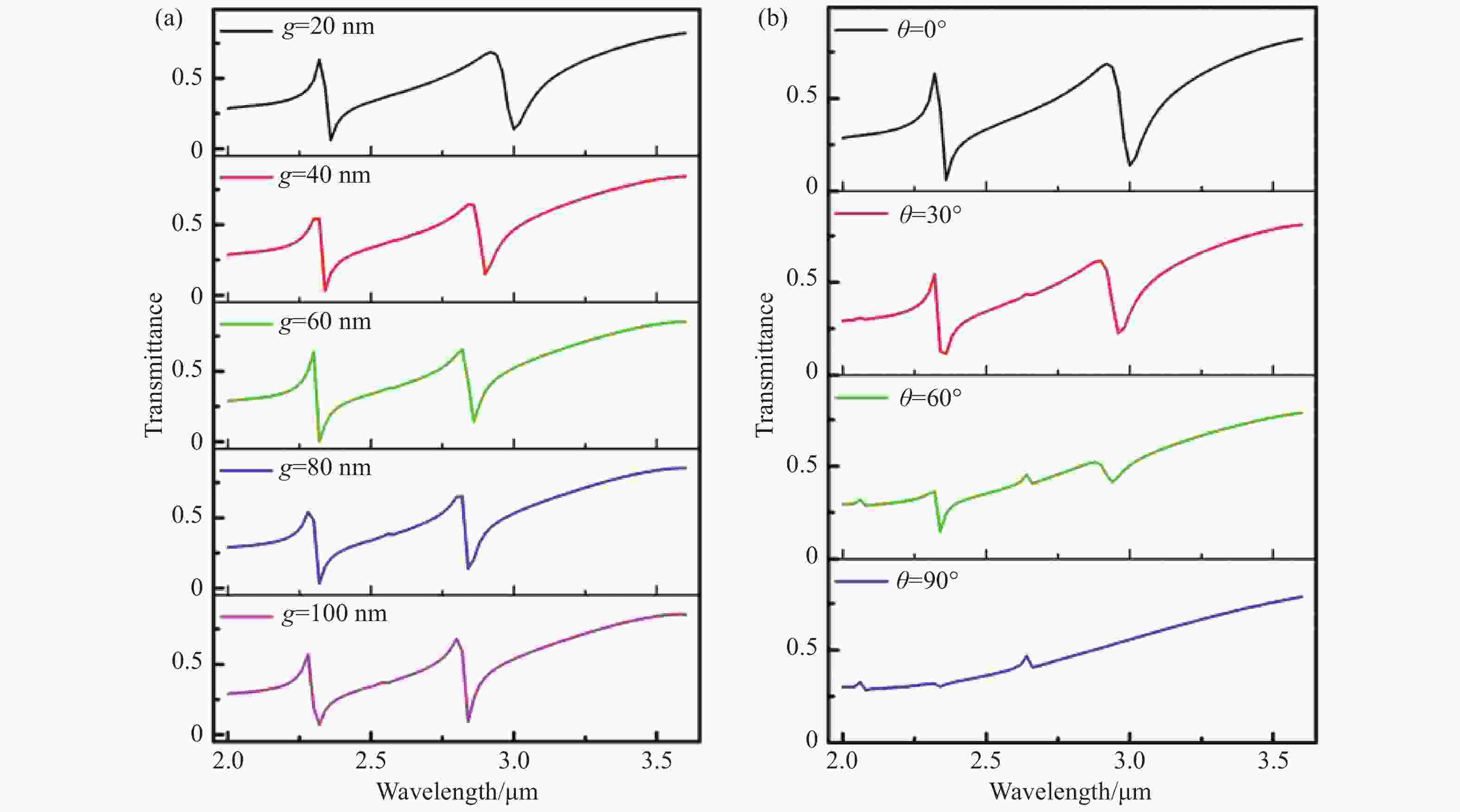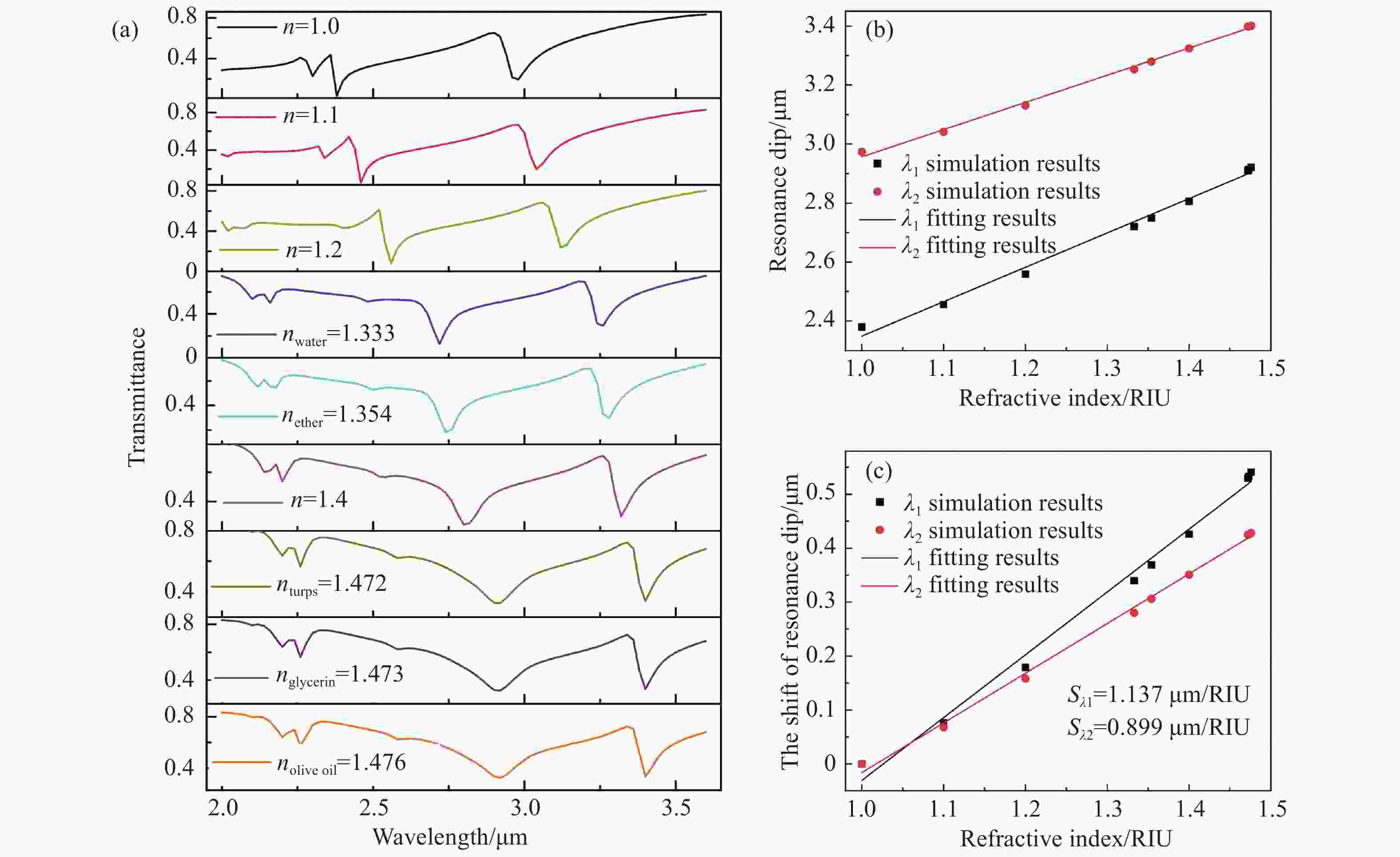Double Fano resonance and refractive index sensors based on parallel-arranged Au nanorod dimer metasurface arrays
doi: 10.37188/CO.EN-2023-0008
-
摘要:
为了研究超表面结构的耦合及折射率传感特性,设计了一种由两种长度不同的纳米棒组成的二聚体结构,并研究该结构的透射光谱,共振峰处的电场和电荷分布以及结构参数对透射光谱的影响。本文采用有限元法对光学性能进行仿真分析,采用准静态逼近模型解释了平行双纳米棒结构的耦合机理。在共振波长上模拟电场分布,分析电子振动模式,在透射光谱中出现了不对称线型的双Fano共振。结果表明,双Fano共振是由纳米棒和衬底之间的耦合作用产生的,可以通过结构参数和周围介质的折射率来调控,且基于Fano共振的折射率灵敏度最大可达1.137 μm/RIU。这些研究结果为设计等离激元传感器提供了理论依据。
Abstract:In order to study the coupling and refractive index sensing properties of a metasurface, asymmetric parallel nanorod dimers consisting of two nanorods with different lengths was proposed and designed. In this paper, the finite element method is used to simulate the optical properties and a quasi-static approximation model is used to explain the coupling mechanism of double parallel nanorods. The transmission spectra, electric field at the resonant peak, charge distribution and the influence of structural parameters on the transmission spectra are studied. The electric field distribution is simulated at the resonance wavelength, the electron vibration mode is analyzed, and asymmetric double Fano resonance appears in the transmission spectrum. The results show that the double Fano resonance is generated by the coupling between the nanorods and the substrate, and the double Fano resonance can be regulated by the structural parameters and the refractive index of the surrounding medium. The sensitivity of the refractive index based on the Fano resonance can reach 1.137 μm/RIU. These results provide a theoretical basis for the design of a surface plasmon refractive index sensor.
-
Key words:
- plasmonic metasurfaces /
- Au nanorods /
- double Fano resonance /
- refractive index sensor
-
Figure 5. The distribution of the normalized square of electric field (|E|2) and the charge density of the double parallel nanorods for symmetry structure at the peak E, G, I and dips F, H, J with the parameter s = 80 nm at λE = 2.26 mm (a), λF = 2.30 mm (b), λG = 2.36 mm (c), λH = 2.90 mm (d), λI = 2.98 mm (e), and λJ = 3.00 mm (f).
-
[1] KILDISHEV A V, BOLTASSEVA A, SHALAEV V M. Planar photonics with metasurfaces[J]. Science, 2013, 339(6125): 1232009. doi: 10.1126/science.1232009 [2] YOON G, TANAKA T, ZENTGRAF T, et al. Recent progress on metasurfaces: applications and fabrication[J]. Journal of Physics D:Applied Physics, 2021, 54(38): 383002. doi: 10.1088/1361-6463/ac0faa [3] SONG Q, KHADIR S, VÉZIAN S, et al. Bandwidth-unlimited polarization-maintaining metasurfaces[J]. Science Advances, 2021, 7(5): eabe1112. doi: 10.1126/sciadv.abe1112 [4] YANG H, HE P, Ou K, et al. Angular momentum holography via a minimalist metasurface for optical nested encryption[J]. Light:Science &Applications, 2013, 12: 78. [5] ARBABI A, HORIE Y, BAGHERI M, et al. Dielectric metasurfaces for complete control of phase and polarization with subwavelength spatial resolution and high transmission[J]. Nature Nanotechnology, 2015, 10(11): 937-943. doi: 10.1038/nnano.2015.186 [6] FLEURY R, SOUNAS D L, ALÙ A. Negative refraction and planar focusing based on parity-time symmetric metasurfaces[J]. Physical Review Letters, 2014, 113(2): 023903. doi: 10.1103/PhysRevLett.113.023903 [7] SMITH D R, SCHURIG D. Electromagnetic wave propagation in media with indefinite permittivity and permeability tensors[J]. Physical Review Letters, 2003, 90(7): 077405. doi: 10.1103/PhysRevLett.90.077405 [8] LIU Y H, ZHOU X, SONG K, et al. Ultrathin planar chiral metasurface for controlling gradient phase discontinuities of circularly polarized waves[J]. Journal of Physics D:Applied Physics, 2015, 48(36): 365301. doi: 10.1088/0022-3727/48/36/365301 [9] ADATO R, YANIK A A, AMSDEN J J, et al. Ultra-sensitive vibrational spectroscopy of protein monolayers with plasmonic nanoantenna arrays[J]. Proceedings of the National Academy of Sciences of the United States of America, 2009, 106(46): 19227-19232. doi: 10.1073/pnas.0907459106 [10] WU X L, ZHENG Y, LUO Y, et al. A four-band and polarization-independent BDS-based tunable absorber with high refractive index sensitivity[J]. Physical Chemistry Chemical Physics, 2021, 23(47): 26864-26873. doi: 10.1039/D1CP04568G [11] CHEN H, CHEN Z H, YANG H, et al. Multi-mode surface plasmon resonance absorber based on dart-type single-layer graphene[J]. RSC Advances, 2022, 12(13): 7821-7829. doi: 10.1039/D2RA00611A [12] WU C, KHANIKAEV A B, SHVETS G. Broadband slow light metamaterial based on a double-continuum Fano resonance[J]. Physical Review Letters, 2011, 106(10): 107403. doi: 10.1103/PhysRevLett.106.107403 [13] MANJAPPA M, CHIAM S Y, CONG L Q, et al. Tailoring the slow light behavior in terahertz metasurfaces[J]. Applied Physics Letters, 2015, 106(18): 181101. doi: 10.1063/1.4919531 [14] LU C C, HU X Y, SHI K B, et al. An actively ultrafast tunable giant slow-light effect in ultrathin nonlinear metasurfaces[J]. Light:Science &Applications, 2015, 4(6): e302. [15] XU H X, HU G, Kong X, et al. Super-reflector enabled by non-interleaved spin-momentum-multiplexed metasurface[J]. Light:Science &Applications, 2023, 12: 79. [16] FANO U. Effects of configuration interaction on intensities and phase shifts[J]. Physical Review, 1961, 124(6): 1866-1878. doi: 10.1103/PhysRev.124.1866 [17] CHAU Y F C, JIANG J C, CHAO C T C, et al. Manipulating near field enhancement and optical spectrum in a pair-array of the cavity resonance based plasmonic nanoantennas[J]. Journal of Physics D:Applied Physics, 2016, 49(47): 475102. doi: 10.1088/0022-3727/49/47/475102 [18] LIN J, Qiu M, Zhang X, et al. Tailoring the lineshapes of coupled plasmonic systems based on a theory derived from first principles[J]. Light:Science &Applications, 2020, 9: 158. [19] CHEN M W, CHAU Y F, TSAI D P. Three-dimensional analysis of scattering field interactions and surface Plasmon resonance in coupled silver nanospheres[J]. Plasmonics, 2008, 3(4): 157-164. doi: 10.1007/s11468-008-9069-8 [20] CHAO C T C, CHAU Y F C, CHIANG H P. Highly sensitive metal-insulator-metal plasmonic refractive index sensor with a centrally coupled nanoring containing defects[J]. Journal of Physics D:Applied Physics, 2021, 54(11): 115301. doi: 10.1088/1361-6463/abce7f [21] CHAO C T C, CHAU Y F C, CHIANG H P. Multiple Fano resonance modes in an ultra-compact plasmonic waveguide-cavity system for sensing applications[J]. Results in Physics, 2021, 27: 104527. doi: 10.1016/j.rinp.2021.104527 [22] SINGH R, CAO W, AL-NAIB I, et al. Ultrasensitive terahertz sensing with high-Q Fano resonances in metasurfaces[J]. Applied Physics Letters, 2014, 105(17): 171101. doi: 10.1063/1.4895595 [23] MODI K S, KAUR J, SINGH S P, et al. Extremely high figure of merit in all-dielectric split asymmetric arc metasurface for refractive index sensing[J]. Optics Communications, 2020, 462: 125327. doi: 10.1016/j.optcom.2020.125327 [24] LEE K L, HSU H Y, YOU M L, et al. Highly sensitive aluminum-based biosensors using tailorable Fano resonances in capped nanostructures[J]. Scientific Reports, 2017, 7(1): 44104. doi: 10.1038/srep44104 [25] NOZAKI K, SHINYA A, MATSUO S, et al. Ultralow-energy and high-contrast all-optical switch involving Fano resonance based on coupled photonic crystal nanocavities[J]. Optics Express, 2013, 21(10): 11877-11888. doi: 10.1364/OE.21.011877 [26] HAO F, SONNEFRAUD Y, VAN DORPE P, et al. Symmetry breaking in plasmonic nanocavities: subradiant LSPR sensing and a tunable Fano resonance[J]. Nano Letters, 2008, 8(11): 3983-3988. doi: 10.1021/nl802509r [27] FANG ZH Y, CAI J Y, YAN ZH B, et al. Removing a wedge from a metallic nanodisk reveals a Fano resonance[J]. Nano Letters, 2011, 11(10): 4475-4479. doi: 10.1021/nl202804y [28] YANG D J, YANG ZH J, LI Y Y, et al. Tunable Fano resonance in rod-ring plasmonic nanocavities[J]. Plasmonics, 2015, 10(2): 263-269. doi: 10.1007/s11468-014-9804-2 [29] ZHENG CH J, JIA T Q, ZHAO H, et al. Low threshold tunable spaser based on multipolar Fano resonances in disk–ring plasmonic nanostructures[J]. Journal of Physics D:Applied Physics, 2016, 49(1): 015101. doi: 10.1088/0022-3727/49/1/015101 [30] WANG N, ZEISBERGER M, HUEBNER U, et al. Symmetry-breaking induced magnetic Fano resonances in densely packed arrays of symmetric nanotrimers[J]. Scientific Reports, 2019, 9(1): 2873. doi: 10.1038/s41598-019-39779-x [31] ZHANG Y, YUE P, LIU J Y, et al. Ideal magnetic dipole resonances with metal-dielectric-metal hybridized nanodisks[J]. Optics Express, 2019, 27(11): 16143-16155. doi: 10.1364/OE.27.016143 [32] ZHANG B X, ZHAO Y H, HAO Q ZH, et al. Polarization-independent dual-band infrared perfect absorber based on a metal-dielectric-metal elliptical nanodisk array[J]. Optics Express, 2011, 19(16): 15221-15228. doi: 10.1364/OE.19.015221 [33] LI Q, GAO J S, YANG H G, et al. Tunable plasmonic absorber based on propagating and localized surface plasmons using metal-dielectric-metal structure[J]. Plasmonics, 2017, 12(4): 1037-1043. doi: 10.1007/s11468-016-0356-5 [34] LI H Y, ZHOU SH M, LI J, et al. Analysis of the Drude model in metallic films[J]. Applied Optics, 2001, 40(34): 6307-6311. doi: 10.1364/AO.40.006307 [35] ARTAR A, YANIK A A, ALTUG H. Directional double Fano resonances in plasmonic hetero-oligomers[J]. Nano Letters, 2011, 11(9): 3694-3700. doi: 10.1021/nl201677h [36] KHAN A D. Refractive index sensing with fano resonant L-shaped metasurface[J]. Optical Materials, 2018, 82: 168-174. doi: 10.1016/j.optmat.2018.05.066 [37] HOANG T T, PHAM T S, NGUYEN X B, et al. High contrast and sensitive near-infrared refractive index sensors based on metal-dielectric-metal plasmonic metasurfaces[J]. Physica B:Condensed Matter, 2022, 631: 413469. doi: 10.1016/j.physb.2021.413469 [38] LI SH, JIANG H, ZHU X J, et al. A high-sensitivity refractive index sensor with period-doubling plasmonic metasurfaces to engineer the radiation losses[J]. ACS Applied Optical Materials, 2023, 1(3): 736-744. doi: 10.1021/acsaom.2c00183 [39] WU X J, DOU C, XU W, et al. Multiple Fano resonances in nanorod and nanoring hybrid nanostructures[J]. Chinese Physics B, 2019, 28(1): 014204. doi: 10.1088/1674-1056/28/1/014204 [40] RAKHSHANI M R. Tunable and sensitive refractive index sensors by plasmonic absorbers with circular arrays of nanorods and nanotubes for detecting cancerous cells[J]. Plasmonics, 2020, 15(6): 2071-2080. doi: 10.1007/s11468-020-01237-0 -





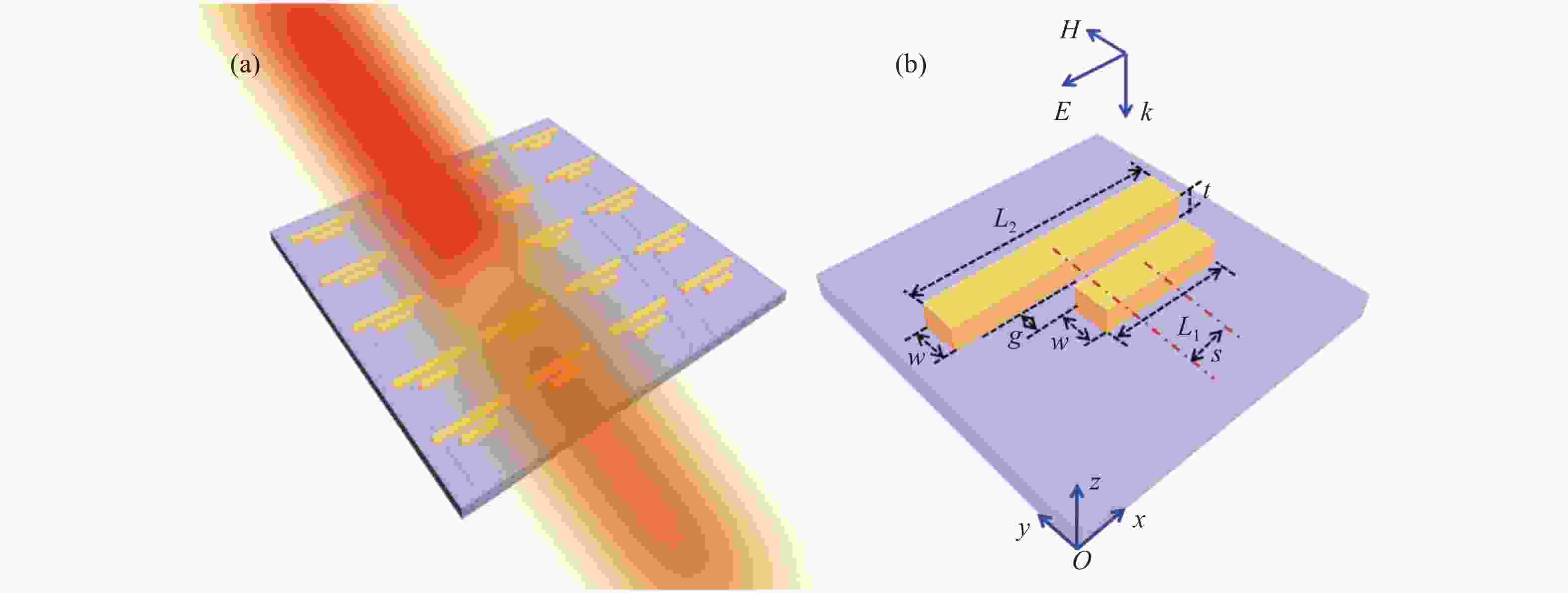
 下载:
下载:


